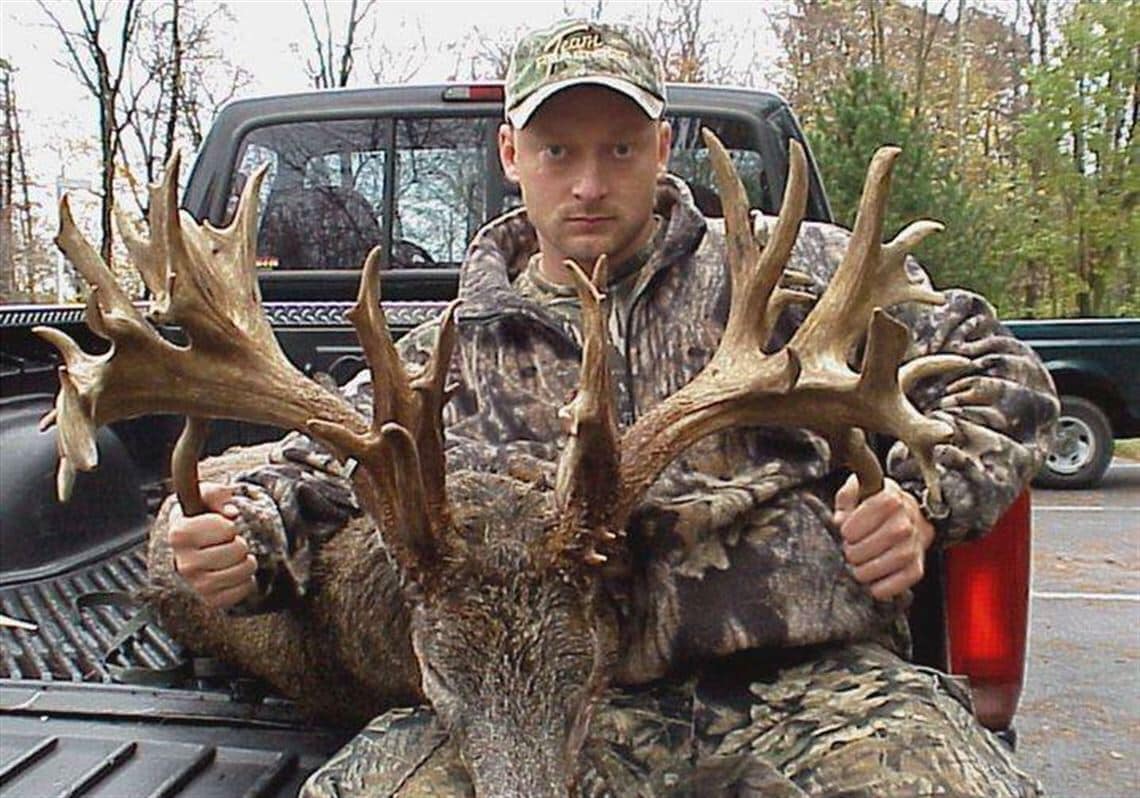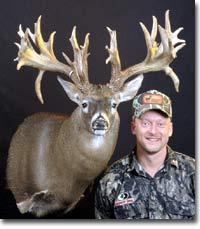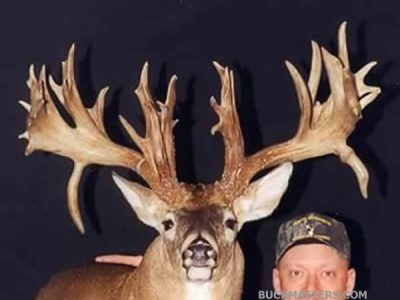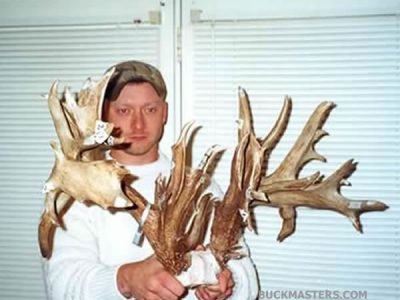Mike Beatty Buck

Story:
Amazing 39-Point Beatty Buck
September 22, 2010
By: Mike Beatty (Originally published on northamericanwhitetail.com)
When I moved to western Ohio from my native Pennsylvania years ago, my brother-in-law, Jerry Michael, told me I was now in an area where the bucks get really big. On the fateful afternoon of Nov. 8, 2000, I learned just how right he was.
At 4 p.m. that day, I pulled in to park my truck near the edge of a corn field on the Greene County farm I had permission to hunt. The temperature was in the mid-50s, with a fog and a light breeze. As I parked down the lane to park, I looked to the left and saw two does bedded in grass alongside the field. I rolled down the truck window to try to snap some photos of the deer, but they were out of good camera range.
After parking and gathering my gear, I walked over a grassy knob and entered the field, moving quietly through the wet corn stalks. When I reached a narrow finger of woods on the far side of the corn, I set out some scent bombs near my tree stand, which was 18 feet up in a pin oak roughly 10 yards from the field’s edge. Within a few minutes I’d climbed into the stand and prepared myself for action.
I saw no deer for a while. Then, at around 5 p.m., I hit my Primos doe-bleat call. Perhaps five minutes passed before I saw a deer sneaking in from behind me at a range of roughly 40 yards.
The animal was to the southwest of my stand and was moving upwind toward me. As I watched, I saw it was a big buck; in fact, it was a high, wide 8-pointer my 10-year-old son, Andrew, and I had been watching all summer.
As the buck stopped to work a scrape perhaps 30 yards from me, I hit the doe-bleat call one more time. Suddenly, here he came, walking to within just 15 yards of my position before stopping behind a thorny locust tree. While he was standing there, his body hidden in the branches, I was shaking so badly I felt my knees knocking. I was at full draw, but with no shooting lanes cut, I couldn’t get a clear shot. All I could do was hope the buck walked into an opening.
He didn’t. Instead, he turned and walked away, back down that brushy draw in which he’d approached. As he did, I disappointedly let my bow down. I just watched the buck of a lifetime walk away, I said to myself as the 8-pointer faded away in the thick cover.
Once he was out of sight, I tried my grunt call a couple of times, then very lightly rattled a set of antlers. After that I watched and waited for his return, but saw nothing.
Reasoning that the doe bleat might work again, I finally gave three more calls on it, waiting a bit between each one. Sure enough, after several minutes I again spotted a buck roughly 30 yards away, sneaking up that thick draw toward me. Although the wind had started to pick up on the back of my neck, pushing my scent in the deer’s direction, he apparently couldn’t smell me as he approached.
Assuming this was the big 8-pointer, I stood up, grabbed my bow and prepared for a shot. But as the buck got closer, I could tell he wasn’t the same deer. This one had an even bigger and more massive rack – much bigger and much more massive! And he was heading toward one of my three scent bombs I’d hung!
At this point, all I could tell about the buck was that he was huge. As he ducked his head to go under a low-hanging branch on the thorn tree, I seized my chance to draw the bow.
Focus . . . just focus, I said to myself as I stood there at full draw, trying to maintain what was left of my composure. As I watched through my peep sight, the buck kept moving toward me. Finally he was within 12 yards, quartering in and facing straight toward me.
I began hunting deer with a gun in my native Pennsylvania at the age of 12, and three years later I took up bowhunting. Going into the 2000 season I’d been hunting with archery gear for 16 years, and in that span I’d arrowed perhaps 10 whitetails. But my biggest had been an 8-pointer that would score around 120 points – not exactly the size deer that would fully prepare a person for a chance at a world-class non-typical. Still, here I was, looking through my peep sight at this great buck and waiting for just the right moment to aim and shoot.
The buck apparently then caught a whiff of one of the scent bombs, because after ducking under that limb, he began to do a lip curl. As his head came up, I saw the chance I’d been hoping for.
Given the position of the deer’s body, I reasoned that if I hit him in the right spot on the neck, my arrow should angle back into the chest cavity, taking out a lung in the process. And so, with the buck’s head tilted upward in that classic lip-curl position, I settled my sight pin on what I figured was the right point and tripped my release.
Smack! As the arrow struck, the buck whirled and took off, resembling a bull elk as he bolted through the trees. It sounded as though his massive antlers hit every branch in the woods as he ran. After watching the monster for perhaps 100 yards, I lost sight of him in the cover.
By then my adrenaline was flowing nonstop, and I was frantic. I took a few deep breaths and began to shuffle around on the 18×24-inch platform of my stand. Finally, I decided I should lower my bow to the ground and climb out of the tree – before I fell out of it!
Once safely on the ground, I sat down for perhaps five minutes to gather my thoughts, then went to look for my arrow. Only 10 paces from my tree I found a single white feather of my fletching, but the arrow itself was nowhere in sight. I looked a bit more and discovered a bit of dark-red blood, so I knew the buck was hit. At that point, I went back to my bow and other gear and sat back down. By then it was 5:45, and with the heavy cloud cover, darkness was rapidly approaching.
After waiting an excruciating 30 minutes, I grabbed my flashlight, bow and knife and went out in search of the buck. Once I’d followed his blood trail a short distance, it became easier to follow; in fact, there suddenly was so much blood it looked as though someone had tipped over a can of red paint and had run through the woods with it.
Every so often I’d find a large patch of blood, and at one point thick, foamy pink blood, which indicated to me that my arrow had indeed reached the lungs.
The buck had headed down the draw southwest of my stand, zigzagging through thick brush en route. Never having had an arrowed deer travel more than 60 yards after the shot, I soon began to shine my light ahead of me in the woods, as I figured the buck would be lying dead just up the trail. But the blood kept going and going.
Finally, when I was a bit over 250 yards from my stand, I heard a deer blow. I immediately turned off my flashlight and listened. I could hear a deer milling around in the woods. But was it my deer?
After turning my light back on, I followed the blood only another 10 yards or so before coming to the edge of a fenced cattle pasture containing some timber and open areas. Now I had a choice to contemplate: Should I keep going or wait for daylight to continue my search? It was the toughest decision I’ve ever had to make as a deer hunter.
When I reached the pasture fence, instead of crossing, I placed one of my arrows against it, turned around and walked back to my truck. Despite the wet weather and uncertain trailing conditions, I’d elected to wait until morning to take up the trail again. If the buck was still alive, I didn’t want to risk pushing him any farther.
As I was driving home that evening the drizzle stopped, which made me feel better about my decision to leave the trail. But needless to say, I couldn’t sleep at all that night, because I was so worried that the rain would wash away the blood. Sure enough, at around 1:30 a.m. it began to rain – hard. As I listened to the downpour my stomach twisted up in knots, and I felt physically ill. I’d arrowed the buck of a lifetime, and he’d left behind a good blood trail. Now I could only hope there would be enough sign left for me to recover him in daylight.
Andrew and I got dressed early and headed out to look for the buck. We got to my hunting area at around 7 a.m., just as dawn was breaking. Rather than retrace the trail from the stand, we walked across the cattle pasture to pick up the buck’s trail where I’d left it the night before.
At least, that was our plan. It changed entirely before we got there.
As we came over a high spot in the pasture, Andrew tugged on my jacket. “Dad, there he is!” he said, pointing ahead. It was my buck – which had died only 30 yards from where I’d quit looking for him the night before.
The closer we got to the deer, the more massive the antlers appeared. There was no ground shrinkage with this buck – instead, it was a case of ground growth! I just couldn’t believe the size of the wide, palmated rack. Later that day I checked in the deer at the Division of Wildlife office in Xenia, where District Wildlife Supervisor Todd Haines and his staff examined the deer and estimated his age at 4 1/2 years. (That later was confirmed through laboratory testing, in which one of the deer’s incisor teeth was cross-sectioned and studied under a microscope. This process is similar to aging a tree by counting its rings.)
On Jan. 7, 2001, following the 60-day drying period, Boone and Crockett measurer Ron Perrine gave the 39-point rack an official entry score of 304 6/8 non-typical. At that score, he was not only the world record for archery but also for any hunter-taken whitetail, bow or gun!
It’s certainly an honor for me to have shot such a tremendous deer, especially with a bow. But to be honest, my fondest memories of the 2000 season won’t be of this buck. Instead, I’ll most remember being able to share the deer season with my son. Having Andrew there when my deer was found made it an even more special moment for me. And when my boy made a clean shot on his first buck later that season, what had already been a magical year around the Beatty house got just that much better.





